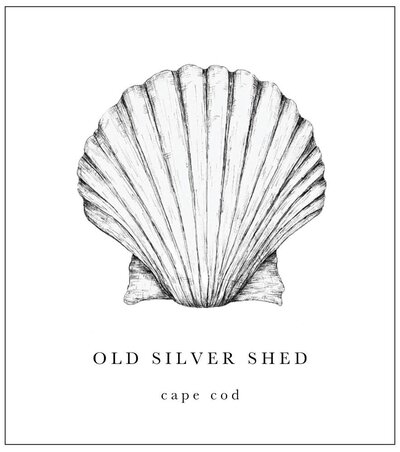Our Center Hall Styling Details
Salt Marsh rug shown here available at Old Silver Shed SHOP. Click on image for more information.
Living on Cape Cod in a house with a lot of windows, my natural instinct is to bring the beauty of outside inside. As you enter our home, you can see straight through the house to the bay beyond, so when styling our center hall I like to work with elements found in our natural surroundings. Creating a gallery-like feel in this area draws my guests in and gives them a reason to linger here.
The artwork I chose for this area is a collection of four breaking-wave studies. The simple pen and ink illustrations are a commission by an artist I discovered on Etsy (Grej Gallery). When framing them, I chose to float the sketches inside an 8 ply matte to create a sculptural feel.
Hanging the four evenly above the cabinet leads your eye to the view outside. Resting on the cabinet are a collection of original vintage water fowl
bookplates (another Etsy find). The muted tones of the art collectively keeps it all easy on your eye and allows for the addition of fresh flowers without being distracting.
Hallways in our home were designed wide and spacious to act as an extension of the adjoining rooms. In our center hall the wall cabinet is used as a buffet when we are entertaining in the dining room, next door. I load the top with cakes, cookies, and sweets and cover them in cloches – they are practical and beautiful. I’ve been collecting cloches for more than 20 years, they are one of the most versatile elements I collect.

The origins of cloches began in the garden, they were used to protect plants, and help them grow. Vintage cloches come in all shapes and sizes, with glass, mostly wavy, ranging from very heavy, to extremely thin and delicate. I love the process of hunting for them and then marrying them with a perfect base. I look for vintage mirror plateaus, old silver plates and trays, and once I used a vintage florist’s metal frog turned upside down to fit a certain cloche perfectly.
(Look closely at the pic below, you can see the metal spikes of the frog.)

Natural seashells, driftwood and a craggy old sea sponge creates a small vignette. A cloche allows me to use found objects in their natural state and it contains the not-so-pleasant odors – you see the sea sponge? It’s stinks like low tide! (And you definetly cannot bleach a sea sponge, it would destroy it’s natural beauty.)
I absolutely LOVE creating beautiful little seasonal displays under my cloches – using broken fragments of a sea fan paired with a perfectly crusty sea shell, creating a still life that catches your eye and calls you in for a closer look. Using them to display found objects and small collections makes those objects feel important and precious, bringing what could be considered insignificant or mundane into a new light. Together, these items have bigger impact. It is a way to contain so many of the small but fascinating things I love to collect without creating the dreaded clutter!

Star fish stacked up high, feel more sculptural to me, like art. Presenting them this way allows you to see the natural variation of color, and their individual uniqueness.

Each season brings new inspiration for a cloche display. During Christmas
I display a beautiful collection of woodland animals from Switzerland in snowy winter scenes. During Easter/Spring I display birds’ nests, eggs
and feathers. There is a certain intimacy in looking at detailed vignette under a cloche.

With the help of a cloche I can make a bigger style statement that lets me continue to collect all the tiny things my eye is drawn to without feeling like I have too much stuff! I think about my mother’s classic assessment of my
home; “You know Sand, you’ve got a lot of crap in this house, but you’d never
know it!” to which I responded, “Mom, I prefer to call it ”contained clutter.”
I found some amazing cloches and added them to my Old Silver Shed Amazon storefront here.






One Response
Love your home & design! What paint color do you use for entry way, dining, living room, kitchen, and the finishes? 🙂